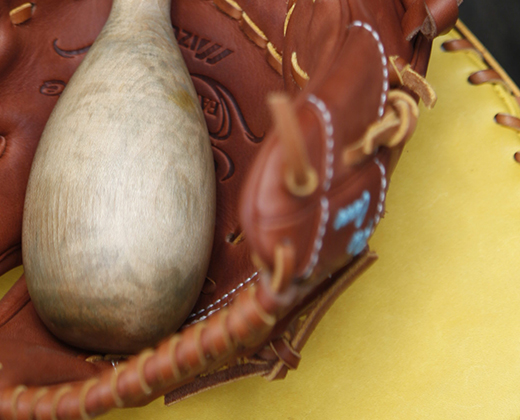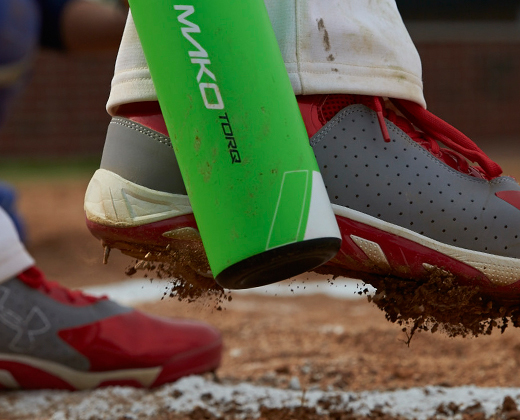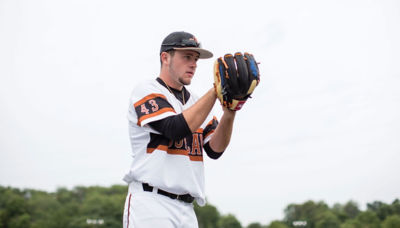How To Play The Outfield Like A Pro
Amplify your game in the outfield with a few tips from a former pro.

To the untrained eye, it may look like outfielders spend most of the game standing around, waiting for a ball to come their way.
But there’s more happening. Outfielders are constantly making adjustments, responding to situations, and trying to stay one step ahead of the action.
Maybe you’re new to the game and want to learn the ins-and-outs of every spot on the field. Or, you might be an experienced player who needs a refresher heading into the upcoming season. With this guide, get to know your position better than ever before, and get ready to reap the rewards on the field.
CENTER FIELD
The center fielder is key because he has the best visuals of the pitcher and hitter. It is often up to the center fielder to tell the right and left fielders how to adjust.
“Positioning in the biggest thing,” said Brian Billigen, a content coordinator at DICK’S Sporting Goods who played professionally as an outfielder in the Arizona Diamondbacks organization. “The center fielder can tell a hitter’s bat path—if they’re late or early on pitches, how the pitcher is attacking that guy."
As the center fielder, you should avoid lining up directly behind the pitcher to avoid obstructing your view. You should also pay close attention to the hitter’s first couple of swings to determine if they’re late or early.
In addition to fielding the position, the center fielder is also responsible for:
- Backing up ground balls hit to the middle infielders
- Backing up the throw from the catcher when a player attempts to steal second base
- Backing up pickoff throws to second base
Here is a breakdown of where the center fielder should be in common situations:
No runners on base
- Base Hit To Right Field: Back up the right fielder.
- Base Hit To Left Field: Back up the left fielder.
- Ball Hit Down Right/Left Field Line: Move toward the ball and be prepared to make the play if the right/left fielder misplays the ball or if the ball bounces wildly off the fence.
- Ball Hit To Right/Left Center Gap: Attempt to get the ball. If the right/left fielder will get there first, adjust and back up the play.
Runners at first base (or first & second, or bases loaded)
- Base Hit To Right Field: Back up the right fielder. If the right fielder successfully fields the ball, head behind second base and be prepared to back up a play.
- Base Hit To Left Field: Back up the left fielder.
LEFT FIELD
The left fielder has plenty to worry about, too. It may be tempting to let your mind wander out there, but you need to keep your head in the game.
“You always want to be moving,” Billigen said. “You never want to be standing in your position not doing anything.”
Here is how the left fielder should move on balls hit to other parts of the outfield:
No runners on base
- Base Hit To Right Field: Back up a potential throw from right field to second base.
- Base Hit To Center Field: Back up the center fielder.
- Ball Hit down Right Field Line/In Right Center Gap: Watch the play develop. Back up the throw to second on a double, or back up the throw to third if the runner goes for a triple.
- Ball To Left Center Gap: Attempt to get the ball. If the center fielder will get there first, adjust to back up the play.
Runner at first base (or first & second, or bases loaded)
- Base Hit To Right Field: Back up the throw to third base from right field. If the first baseman cuts off a throw to home, adjust yourself to back up a throw to third from the first baseman. If the throw goes all the way to home, be prepared to back up a throw to third from the catcher.
- Base Hit To Center Field: Back up the center fielder. If the center fielder successfully fields the ball, head towards the infield—usually third base—to back up a potential throw from an infielder.
- Base Hit To Left Field: After you field the ball and make the throw, back up third base.
RIGHT FIELD
You might look at right field and think there isn’t much action, but there is plenty. In addition to fielding the position, you need to keep a close eye on the infield and be prepared to back up any errant throws at first base.
The right fielder also needs to back up pickoff throws to first. As a right fielder, you might have a good view of your catcher’s signs. Know the pickoff sign, and be prepared to move—just remember, the pitcher can always miss a sign.
Here is what the right fielder should be doing on balls not hit directly to him in the outfield:
No runners on base
- Base Hit To Center Field: Back up center fielder.
- Base Hit To Left Field: Back up second base.
- Ball Hit To Right Center Gap: Attempt to get the ball. If the center fielder will get there first, adjust and back up the play.
- Ball Hit To Left Center Gap/Down Left Field Line: Back up the throw to second base. The first baseman will leave his position to back up this throw, so you are essentially backing up the first baseman.
Runner on first (or runners on first & second, or bases loaded)
- Base Hit To Center Field: Back up center fielder. If the center fielder successfully fields the ball, begin moving towards the infield—usually second base—to back up a potential throw from an infielder.
- Base Hit To Left Field: Be prepared to back up second base or a missed throw to the cutoff man.
BASIC OUTFIELDER TIPS
Calling Off Infielders: It is an outfielder’s right to call off infielders on shallow fly balls, as the outfielder has the better angle. There will be times when communication breaks down and players get too close for comfort. If the infielder does not back off, the outfielder should slide to deter injury.
How To Play The Fence/Wall: “During batting practice, you always want to see if you can feel a difference between the warning track and the grass,” Billigen said. “Make sure you do some practice runs at the fence. See how many strides you have on the warning track.”
What To Focus On In The Offseason: “Footwork is the most important thing,” Billigen said. “That first step is going to make or break you.”
Work on tracking the ball off the bat and sprinting to a spot without looking up. You’re always faster when you’re running without looking up.
Also, work on running on the balls of your feet—the ball won’t appear to bounce as much.
GEAR FOR THE OUTFIELD
Consider getting an outfield glove — they are typically larger with a deep pocket. Also, look for lightweight baseball cleats that will enhance your speed and quickness.








